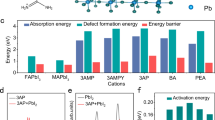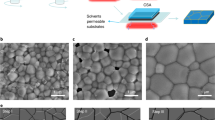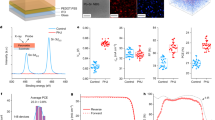Abstract
Perovskite solar cells typically comprise electron- and hole-transport materials deposited on each side of a perovskite active layer. So far, only two organic hole-transport materials have led to state-of-the-art performance in these solar cells1: poly(triarylamine) (PTAA)2,3,4,5 and 2,2ʹ,7,7ʹ-tetrakis(N,N-di-p-methoxyphenylamine)-9,9ʹ-spirobifluorene (spiro-OMeTAD)6,7. However, these materials have several drawbacks in terms of commercialization, including high cost8, the need for hygroscopic dopants that trigger degradation of the perovskite layer9 and limitations in their deposition processes10. Poly(3-hexylthiophene) (P3HT) is an alternative hole-transport material with excellent optoelectronic properties11,12,13, low cost8,14 and ease of fabrication15,16,17,18, but so far the efficiencies of perovskite solar cells using P3HT have reached only around 16 per cent19. Here we propose a device architecture for highly efficient perovskite solar cells that use P3HT as a hole-transport material without any dopants. A thin layer of wide-bandgap halide perovskite is formed on top of the narrow-bandgap light-absorbing layer by an in situ reaction of n-hexyl trimethyl ammonium bromide on the perovskite surface. Our device has a certified power conversion efficiency of 22.7 per cent with hysteresis of ±0.51 per cent; exhibits good stability at 85 per cent relative humidity without encapsulation; and upon encapsulation demonstrates long-term operational stability for 1,370 hours under 1-Sun illumination at room temperature, maintaining 95 per cent of the initial efficiency. We extend our platform to large-area modules (24.97 square centimetres)—which are fabricated using a scalable bar-coating method for the deposition of P3HT—and achieve a power conversion efficiency of 16.0 per cent. Realizing the potential of P3HT as a hole-transport material by using a wide-bandgap halide could be a valuable direction for perovskite solar-cell research.
This is a preview of subscription content, access via your institution
Access options
Access Nature and 54 other Nature Portfolio journals
Get Nature+, our best-value online-access subscription
$29.99 / 30 days
cancel any time
Subscribe to this journal
Receive 51 print issues and online access
$199.00 per year
only $3.90 per issue
Buy this article
- Purchase on Springer Link
- Instant access to full article PDF
Prices may be subject to local taxes which are calculated during checkout




Similar content being viewed by others
Data availability
The data that support the plots within this paper and other findings of this study are available from the corresponding authors upon reasonable request.
References
NREL. Best Research-Cell Efficiencies. National Renewable Energy Laboratory https://www.nrel.gov/pv/assets/images/efficiency-chart.png (2018).
Yang, W. S. et al. Iodide management in formamidinium-lead-halide-based perovskite layers for efficient solar cells. Science 356, 1376–1379 (2017).
Jeon, N. J. et al. Compositional engineering of perovskite materials for high-performance solar cells. Nature 517, 476–480 (2015).
Yang, W. S. et al. High-performance photovoltaic perovskite layers fabricated through intramolecular exchange. Science 348, 1234–1237 (2015).
Jeon, N. J. et al. Solvent engineering for high-performance inorganic–organic hybrid perovskite solar cells. Nat. Mater. 13, 897–903 (2014).
Bi, D. et al. Polymer-templated nucleation and crystal growth of perovskite films for solar cells with efficiency greater than 21%. Nat. Energy 1, 16142 (2016).
Burschka, J. et al. Sequential deposition as a route to high-performance perovskite-sensitized solar cells. Nature 499, 316–319 (2013).
Zhang, M. et al. Stable and low-cost mesoscopic CH3NH3PbI2Br perovskite solar cells by using a thin poly(3-hexylthiophene) layer as a hole transporter. Chem. Eur. J. 21, 434–439 (2015).
Rong, Y., Liu, L., Mei, A., Li, X. & Han, H. Beyond efficiency: the challenge of stability in mesoscopic perovskite solar cells. Adv. Energy Mater. 5, 1501066-n/a (2015).
Qin, T. et al. Amorphous hole-transporting layer in slot-die coated perovskite solar cells. Nano Energy 31, 210–217 (2017).
Ludwigs, S. P3HT Revisited – From Molecular Scale to Solar Cell Devices Ch. 2 (Springer, Berlin, 2014).
Sirringhaus, H. et al. Two-dimensional charge transport in self-organized, high-mobility conjugated polymers. Nature 401, 685 (1999).
Kim, Y. et al. Strong regioregularity effect in self-organizing conjugated polymer films and high-efficiency polythiophene:fullerene solar cells. Nat. Mater. 5, 197 (2006).
Osedach, T. P., Andrew, T. L. & Bulović, V. Effect of synthetic accessibility on the commercial viability of organic photovoltaics. Energy Environ. Sci. 6, 711–718 (2013).
Osaka, I. & McCullough, R. D. Advances in molecular design and synthesis of regioregular polythiophenes. Acc. Chem. Res. 41, 1202–1214 (2008).
Hwang, K. et al. Toward large scale roll-to-roll production of fully printed perovskite solar cells. Adv. Mater. 27, 1241–1247 (2015).
Brabec, C. J. & Durrant, J. R. Solution-processed organic solar cells. MRS Bull. 33, 670–675 (2008).
Krebs, F. C., Gevorgyan, S. A. & Alstrup, J. A roll-to-roll process to flexible polymer solar cells: model studies, manufacture and operational stability studies. J. Mater. Chem. 19, 5442–5451 (2009).
Nia, N. Y., Matteocci, F., Cina, L. & Di Carlo, A. High-efficiency perovskite solar cell based on poly(3-hexylthiophene): influence of molecular weight and mesoscopic scaffold layer. ChemSusChem 10, 3854–3860 (2017).
Stolterfoht, M. et al. The perovskite/transport layer interfaces dominate non-radiative recombination in efficient perovskite solar cells. Preprint at https://arxiv.org/abs/1810.01333 (2018).
Bi, D., Yang, L., Boschloo, G., Hagfeldt, A. & Johansson, E. M. J. Effect of different hole transport materials on recombination in CH3NH3PbI3 perovskite-sensitized mesoscopic solar cells. J. Phys. Chem. Lett. 4, 1532–1536 (2013).
Brauer, J. C., Lee, Y. H., Nazeeruddin, M. K. & Banerji, N. Charge transfer dynamics from organometal halide perovskite to polymeric hole transport materials in hybrid solar cells. J. Phys. Chem. Lett. 6, 3675–3681 (2015).
Taguchi, M. et al. 24.7% record efficiency HIT solar cell on thin silicon wafer. IEEE J. Photovolt. 4, 96–99 (2014).
Yang, S. et al. Functionalization of perovskite thin films with moisture-tolerant molecules. Nat. Energy 1, 15016 (2016).
Tsoi, W. C. et al. The nature of in-plane skeleton Raman modes of P3HT and their correlation to the degree of molecular order in P3HT:PCBM blend thin films. J. Am. Chem. Soc. 133, 9834–9843 (2011).
Chen, H. et al. A solvent- and vacuum-free route to large-area perovskite films for efficient solar modules. Nature 550, 92–95 (2017).
Wang, G., Swensen, J., Moses, D. & Heeger, A. J. Increased mobility from regioregular poly(3-hexylthiophene) field-effect transistors. J. Appl. Phys. 93, 6137 (2003).
Veres, J., Ogier, S. & Lloyd, G. Gate insulators in organic field-effect transistors. Chem. Mater. 16, 4543–4555 (2004).
Shi, D. et al. Spiro-OMeTAD single crystals: Remarkably enhanced charge-carrier transport via mesoscale ordering. Sci. Adv. 2, e1501491 (2016).
Pysch, D., Mette, A. & Glunz, S. W. A review and comparison of different methods to determine the series resistance of solar cells. Sol. Energy Mater. Sol. Cells 91, 1698–1706 (2007).
Acknowledgements
This work was supported by a grant from the Korea Research Institute of Chemical Technology (KRICT), South Korea (KK1802-A01); the Korea Institute of Energy Technology Evaluation and Planning (KETEP) and the Ministry of Trade Industry & Energy (MOTIE) of South Korea (20163010012470); and by a grant from the National Research Foundation of Korea (NRF) funded by the Ministry of Science, ICT & Future Planning (MSIP) of South Korea (NRF-2016M3A6A7945503). J.H.N. acknowledges financial support from an NRF grant funded by the South Korean government (MSIP) (2017R1A2B2009676, 2017R1A4A1015022).
Reviewer information
Nature thanks Ardalan Armin and the other anonymous reviewer(s) for their contribution to the peer review of this work.
Author information
Authors and Affiliations
Contributions
E.H.J., J.H.N. and J.S. conceived the idea and wrote the manuscript. E.H.J. and T.J.S. performed GIWAXS experiments and analysed the data. E.H.J. performed scanning electron microscopy, HRTEM, atomic force microscopy, Raman spectroscopy and Mott–Schottky analysis. E.H.J. fabricated and characterized perovskite solar cells with support from N.J.J. and C.S.M. E.H.J., N.J.J., J.H.N. and J.S. obtained the certified performance of devices at Newport Corporation. N.J.J. estimated the long-term stability of the devices with input from T.-Y.Y. E.Y.P. fabricated and characterized perovskite solar modules. J.H.N. and J.S. supervised this project. All authors discussed the results.
Corresponding authors
Ethics declarations
Competing interests
The authors declare no competing interests.
Additional information
Publisher’s note: Springer Nature remains neutral with regard to jurisdictional claims in published maps and institutional affiliations.
Extended data figures and tables
Extended Data Fig. 1 Linecut profiles of GIWAXS patterns.
a, b, Out-of-plane (a) and in-plane (b) linecut profiles of NBH and DHA films. These patterns correspond to Fig. 2b, c.
Extended Data Fig. 2 Investigation of the composition of HTABx(FAPbI3)0.95(MAPbBr3)0.05 for development of the WBH.
a, X-ray diffraction spectra of HTABx(FAPbI3)0.95(MAPbBr3)0.05 films (x = 0.0, 0.1, 0.2, 0.3 and 0.4). Only the spectrum of the film in which x = 0.3 shows a distinct peak at a 2θ value of 5.4°, corresponding to the signal at a qz of 0.39 Å−1 along the direction perpendicular to the substrate that was obtained from the DHA film in the GIWAXS pattern of Fig. 1c and Extended Data Fig. 1a. This indicates that the crystalline WBH thin layer in the DHA configuration should be formed with a composition close to x = 0.3. b, Tauc plots of (FAPbI3)0.95(MAPbBr3)0.05 (NBH) and HTAB0.3(FAPbI3)0.95(MAPbBr3)0.05 (WBH) films.
Extended Data Fig. 3 Effect of the concentration of HTAB on the development of the WBH layer.
a–d, Scanning electron microscopy images of the pristine perovskite surface (a), and perovskite surfaces treated with 0.5 mM (b), 1.0 mM (c) and 1.5 mM (d) HTAB solution. The scale bar (500 nm) in a also applies to the other images.
Extended Data Fig. 4 The distribution of lead in cross-sections of control and DHA films.
Scanning TEM images of the control (a) and DHA (c) films, near to the film surface. HAADF scanning TEM images of the control (b) and DHA (d) films.
Extended Data Fig. 5 Energy-level alignment in DHA-based perovskite solar cells containing P3HT.
a, Ultraviolet photoelectron spectra of NBH, WBH and P3HT. b, Energy-level diagram of NBH, WBH and P3HT. The Fermi levels and valence-band maxima were obtained by ultraviolet photoelectron spectroscopy, and the conduction band minima were determined by adding the optical bandgaps to the valence-band maxima.
Extended Data Fig. 6 Reduced trap-assisted recombination.
a, J−V curves of control and DHA devices without hole-transport material (FTO/d-TiO2/mp-TiO2/NBH/(WBH)/Au). b, Time-resolved photoluminescence decays of control perovskite and DHA.
Extended Data Fig. 7 Optimized alkyl chain length of the alkyl trimethylammonium bromide for high-performance perovskite solar cells containing P3HT.
a, Raman spectra of control and DHA devices treated with various alkyl trimethylammonium bromides (butyl- (C4), hexyl- (C6), octyl- (C8) and decyl- (C10)) and covered with P3HT under excitation at 514 nm. b, Maximum intensity of the symmetric C=C stretch mode (around 1,446 cm−1) obtained from the corresponding samples. c, J−V curves of DHA devices treated with various alkyl trimethylammonium bromides, containing P3HT as an HTM. d, Summary of photovoltaic parameters obtained from the corresponding J−V curves.
Extended Data Fig. 8 Certificate of photovoltaic performance obtained from DHA solar cells using P3HT.
The photovoltaic parameters are summarized in the table on the certificate. The external quantum efficiency spectrum was obtained from the corresponding device.
Extended Data Fig. 9 Effects of DHA configuration on photovoltaic performance using various dopant-free organic HTMs.
a–d, J−V curves of the control device (red) and the DHA device (blue) using PTAA (a), spiro-OMeTAD (b), PCPDTBT (c) and PTB7 (d) without any dopants. Solid and dashed lines indicate J−V curves measured along the reverse-scan and the forward-scan direction, respectively.
Extended Data Fig. 10 Series resistance of control and DHA devices with or without P3HT.
a, I−V plots of control and DHA films without an electron-transport layer and a hole-transport layer. b, J−V curves of control and DHA devices under 1-Sun illumination, and J−V curves shifted by the short-circuit current density (JSC) of the corresponding devices under dark conditions30.
Extended Data Fig. 11 Schematic architecture of the perovskite module.
a, Top view of the entire module, including the glass substrate. The active strips, gold electrode, designated illumination area and glass substrate are indicated in black, yellow, red and blue, respectively. b, Top view of the eight active strips in the module. The units in a and b are miliimetres. c, Side view of an interval between adjacent active strips in the module. The vertical length scale is arbitrarily set to show the structure of the interval.
Rights and permissions
About this article
Cite this article
Jung, E.H., Jeon, N.J., Park, E.Y. et al. Efficient, stable and scalable perovskite solar cells using poly(3-hexylthiophene). Nature 567, 511–515 (2019). https://doi.org/10.1038/s41586-019-1036-3
Received:
Accepted:
Published:
Issue Date:
DOI: https://doi.org/10.1038/s41586-019-1036-3
Comments
By submitting a comment you agree to abide by our Terms and Community Guidelines. If you find something abusive or that does not comply with our terms or guidelines please flag it as inappropriate.



